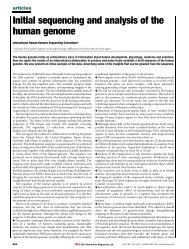Predictors of Foreign-Language Anxiety: Examining the ...
Predictors of Foreign-Language Anxiety: Examining the ...
Predictors of Foreign-Language Anxiety: Examining the ...
You also want an ePaper? Increase the reach of your titles
YUMPU automatically turns print PDFs into web optimized ePapers that Google loves.
CompetitivenessThe idea that language anxiety may also stem from ano<strong>the</strong>r personal trait, competitiveness,comes from an <strong>of</strong>t-cited diary study (Bailey, 1983). Bailey (1983, p. 96)defines competitiveness as a learner’s “desire to excel in comparison to o<strong>the</strong>rs”,which may manifest itself in learner characteristics such as: (1) overtly comparingoneself to classmates and personal expectations, (2) a feeling <strong>of</strong> having to outdoo<strong>the</strong>r learners, (3) and a preoccupation with tests and grades, especially with referenceto o<strong>the</strong>r students. According to Bailey’s hypo<strong>the</strong>sis, anxiety results whencompetitive learners perceive <strong>the</strong>mselves as less competent compared to o<strong>the</strong>rs,that is, when <strong>the</strong>y feel unable to compete.Since evidence for <strong>the</strong> relationship between anxiety and both perfectionismand competitiveness has been cited from qualitative studies involving a smallnumber <strong>of</strong> learners (eight in Gregersen & Horwitz, 2002, and ten in Price, 1991 andBailey, 1983), quantitative inquiries, using larger samples <strong>of</strong> language learners areneeded to verify <strong>the</strong> findings <strong>of</strong> <strong>the</strong>se small-scale investigations.Statement <strong>of</strong> purposeAs <strong>the</strong> review shows, current assumptions about how FLA is related to <strong>the</strong> selectedlearner variables are based on <strong>the</strong> results <strong>of</strong> studies investigating <strong>the</strong> relationship<strong>of</strong> a given variable to FLA in isolation (as in <strong>the</strong> case <strong>of</strong> pr<strong>of</strong>iciency, FLaptitude, motivation, L2-related self-perceptions), or on <strong>the</strong> findings <strong>of</strong> qualitativeinquiries with a small number <strong>of</strong> participants (competitiveness and perfectionism).The aim <strong>of</strong> this study is to test <strong>the</strong>se assumptions, examining all <strong>the</strong>se learner variablesas potential predictors <strong>of</strong> FLA toge<strong>the</strong>r in <strong>the</strong> same sample <strong>of</strong> learners: firstyear English majors from <strong>the</strong> same university. The research questions <strong>of</strong> <strong>the</strong> studyare as follows:What is <strong>the</strong> strength and direction <strong>of</strong> <strong>the</strong> relationship between each <strong>of</strong> <strong>the</strong> selectedlearner variables – pr<strong>of</strong>iciency level, FL aptitude, strength <strong>of</strong> motivation, L2self-concept, perfectionism, and competitiveness – and participants’ feelings <strong>of</strong>FLA? What relative contribution do <strong>the</strong> same variables make to <strong>the</strong> prediction <strong>of</strong>FLA?MethodParticipantsThe study was conducted at <strong>the</strong> School <strong>of</strong> English Studies <strong>of</strong> Pázmány PéterCatholic University (PPCU). The participants were English major students in <strong>the</strong>irfirst year <strong>of</strong> study (N = 107). The majority <strong>of</strong> <strong>the</strong>se students were women, with amale-female ratio <strong>of</strong> 24: 83. Their ages ranged from 18 to 24, with an average age<strong>of</strong> 19.37 (SD = 1.17). They had studied English for an average <strong>of</strong> 8.41 years (SD =2.66), with a minimum <strong>of</strong> 3 and a maximum <strong>of</strong> 14 years.Tóth, Zs. <strong>Predictors</strong> <strong>of</strong> foreign-language anxiety 129
















